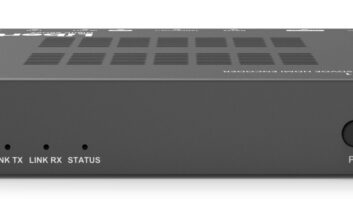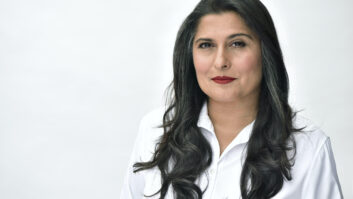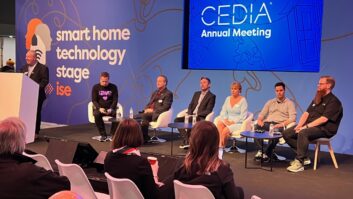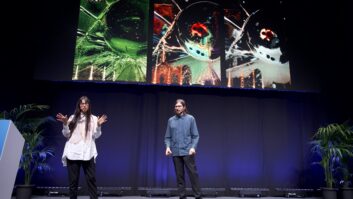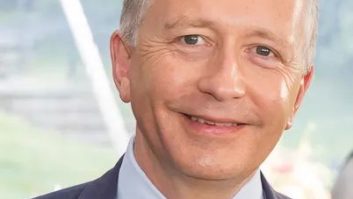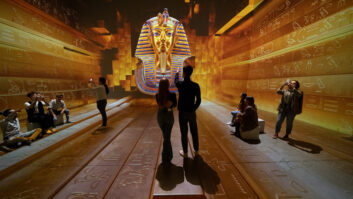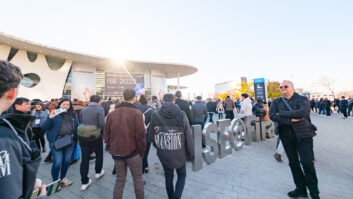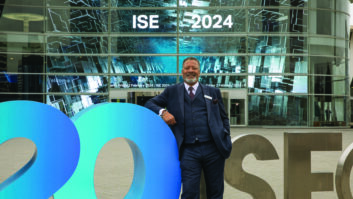Let’s talk about the highlights of the show. I guess the World Masters of Projection Mapping must have been one of the big ones.
Yes it was – but I think it was a very small start to what could become a much bigger event. We’ll soon be doing our assessment on that. We’ll sit down with all the parties involved and we’ll dissect the World Masters of Projection Mapping to see, can we do it better? Should we do it again? How could we do it better?
One of the most significant things about it is that it took the ISE brand out of the RAI and into the wider Amsterdam. Did it attract local interest and coverage?
Definitely. Just about everything covered it from the big newspapers – like the Telegraaf – to some of the TV channels. Obviously our goal is not to get to the general public, but we’re trying to create additional platforms for our industry and to show everybody what ISE is about, and also give something back to the city.
Any other particular key highlights for you?
I think our opening keynote with Carlo Ratti was really good. Some people who I know personally have been quite sceptical about some of our keynotes in the past; when we’ve brought in futurists, they say, they’ve heard it all before. But this time, some of them said to me, “Wow, this is the first time that someone has actually talked about the human element of AV and how it affects us.” I found his presentation very good, very engaging, and I think he was a good choice for us.
Any other thoughts about ISE 2018 in general?
We are obviously very pleased with the attendance results. We’re pleased with the way the show went: there were one or two smaller problems that we found, but on the whole I would say that we had an extremely successful event. The feedback we’re getting from both attendees and exhibitors is very positive, and I think we’ve reinforced our position as the world number one show for the AV industry.
“More and more people are now seeing the advantage and the benefits of coming later to the show, rather than the two busiest days”
You had nearly 20,000 people at the show on Friday. Can more be done to even out the attendance pattern across the four days?
Yes, there is more that can be done. It’s always our challenge and we’re quite realistic. We had 12,000 people the first year we did a fourth day, last year we had almost 17,000 and this year we’ve risen to just a couple of people short of our target of 20,000. And that for us was very encouraging.
I think more and more people are now seeing the advantage and the benefits of coming later to the show, rather than the two busiest days. If you compare it with Day 2, Day 4 looks really quiet, but at our fourth show [ISE 2007] we only had about 17,000 attendees in total. So it’s encouraging to see that this is changing.
But we had almost 40,000 people through on Day 2 and it’s too much for the venue. If all we can achieve next year is to actually reduce the number of people coming on Day 2 and get them to come on Day 4, I think we’ve won the battle.
And you got loads of first-time exhibitors and first-time visitors, which is a good thing.
Absolutely. This is always key. When you have an established show that doesn’t change its attendee base, you get exhibitors saying, “We don’t know why we’re here, we’re only seeing the same people.” That’s not a complaint we hear because we are bringing new people constantly to the show. We lose some people as well, but we’ve always had growth.
What surprised me as well is we’re seeing more and more channel people coming from outside of Europe: North America, Asia, the Middle East, Russia and so on. So we’re really seeing a lot of growth in that direction. That’s been quite encouraging as well.
You also announced after the show that you’ve sold 103% of the floor space compared with 2018. So will you be expanding Hall 15?
No – actually the configuration of Hall 15 will change slightly to be more space-efficient next year. And there are other parts of the building being adapted to create more space. We may well have additional buildings as well, because, we still have some exhibitors to manage and bring under the roof. So we’re looking at how we are able to do that, working with the RAI.
I still like using my old Henry Kissinger quote: “Every success is just a ticket to another problem.” Our growth and success are causing other issues. Ten years ago we had the luxury of having more space in the RAI than we needed. So we created additional catering areas, lounge areas and things like that, like every show organiser. But over the years we’ve been taking those away to create more exhibit space. But we have to feed people as well. So part of our challenge is also creating more catering areas so people actually will stay the day and won’t starve or get thirsty.
I think this is the first year where people have been starting to say the show’s getting too big. What would you say to them?
This is always a danger with every event. One of the issues we have is trying to satisfy the attendees by covering the market. When companies want to present their solutions to the marketplace, we check that they do fit, and they’re right for us, criteria-wise. And then see if we can accommodate them and where.
“We have to be more focused to help our attendees find the right products, services and solutions on the show floor”
When we started ISE, we liked – and the industry liked – the idea that we jumbled everything up [across the show floor]. So attendees went around everything. That was fine when the show was under 5,000sqm, but now we’re over 55,000sqm. We realise that not everybody wants to see everything – and you cannot see the whole show even in four days. So we have to be more focused to help our attendees find the right products, services and solutions on the show floor. So we’ve create tools to help them, and we’ve tried to untangle the floor – though it’s very hard to do that completely – and we’ve created some focus areas, like digital signage, unified communications and pro audio, that are the starting point for attendees.
Will you add more areas along those lines?
We would like to, but at the moment we can’t. We’re having an issue with how can we manage that. It’s part of our long-term goal to see how we can untangle the show floor and create new areas. There are some areas where the industry is evolving that we need to address in some way, but to create a focus area on the show floor and attract even more exhibitors at the moment is not feasible.
Looking ahead to ISE 2019, what new infrastructure is going to be in place? Is the new hotel next to the RAI going to be finished?
The hotel will be ready for us in 2020. It will actually be finished in the spring of 2019, so we will just miss it next year. We could be lucky and they get a mild summer and winter and construction moves faster, but at the moment it’s highly unlikely.
What will be happening is the new metro link will be opening this July, so it will be really tried and tested by the time ISE opens its doors in February 2019. It will give a direct connection to the city, so attendees won’t have to wait in taxi lines all the time. The taxis will still be there, but you will also be able to get a metro from the venue directly downtown in six minutes. So that’s going to be a phenomenal change in terms of moving people around the city.
Any other infrastructure developments?
There are parts of the RAI that are being modernised and changed, and built out to give us additional accommodation. Some of that work is going on during the summer and will be ready for ISE 2019.
And the 64,000-dollar question: what’s happening about the show’s future, with regard to Amsterdam or anywhere else?
ISE works in Amsterdam. We’ve done surveys with our attendees, and asked about various cities around Europe, and the preference is Amsterdam. People can communicate in English, which tends to be the common business language for our industry. It’s easy to get to: there are direct flights to over 300 different destinations. It ticks all the boxes in terms of accommodation: there are lots of hotels, with more being built, lots of restaurants and catering in all different sort of culinary styles. It’s a nice small city that attracts people.
But with the growth rate we’ve got, we are growing faster than the venue can accommodate us, and it’s one of things that we’re looking into, long term. Certainly for the next two years we are still in Amsterdam, and the RAI is working with us to develop new facilities in the venue. And if those facilities are going to be able to accommodate us, then that’s a good enough reason to stay.
This interview appears in the Installation/AV Technology Europe 26-page ISE 2018 review digital supplement.
